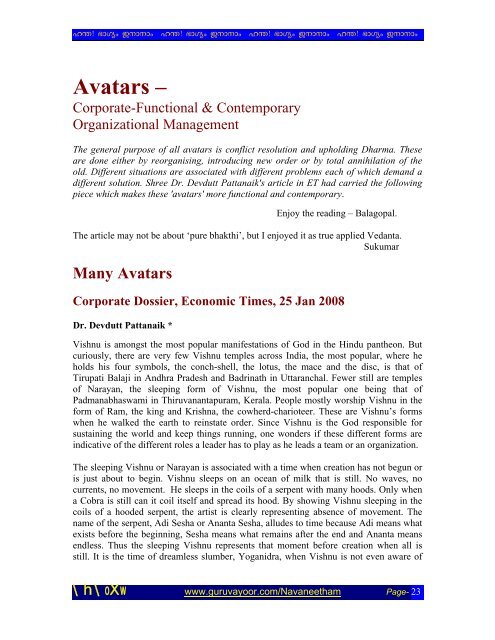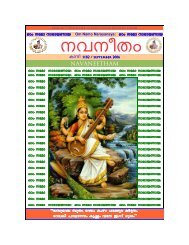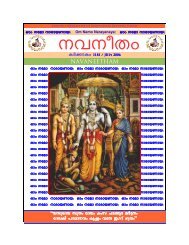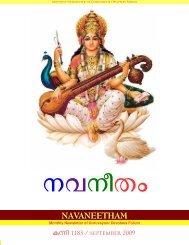Navaneetham - Guruvayoor / Guruvayur
Navaneetham - Guruvayoor / Guruvayur
Navaneetham - Guruvayoor / Guruvayur
You also want an ePaper? Increase the reach of your titles
YUMPU automatically turns print PDFs into web optimized ePapers that Google loves.
pÉ! g¡L¬« Qc¡c¡« pÉ! g¡L¬« Qc¡c¡« pÉ! g¡L¬« Qc¡c¡« pÉ! g¡L¬« Qc¡c¡«<br />
Avatars –<br />
Corporate-Functional & Contemporary<br />
Organizational Management<br />
The general purpose of all avatars is conflict resolution and upholding Dharma. These<br />
are done either by reorganising, introducing new order or by total annihilation of the<br />
old. Different situations are associated with different problems each of which demand a<br />
different solution. Shree Dr. Devdutt Pattanaik's article in ET had carried the following<br />
piece which makes these 'avatars' more functional and contemporary.<br />
Enjoy the reading – Balagopal.<br />
The article may not be about ‘pure bhakthi’, but I enjoyed it as true applied Vedanta.<br />
Sukumar<br />
Many Avatars<br />
Corporate Dossier, Economic Times, 25 Jan 2008<br />
Dr. Devdutt Pattanaik *<br />
Vishnu is amongst the most popular manifestations of God in the Hindu pantheon. But<br />
curiously, there are very few Vishnu temples across India, the most popular, where he<br />
holds his four symbols, the conch-shell, the lotus, the mace and the disc, is that of<br />
Tirupati Balaji in Andhra Pradesh and Badrinath in Uttaranchal. Fewer still are temples<br />
of Narayan, the sleeping form of Vishnu, the most popular one being that of<br />
Padmanabhaswami in Thiruvanantapuram, Kerala. People mostly worship Vishnu in the<br />
form of Ram, the king and Krishna, the cowherd-charioteer. These are Vishnu’s forms<br />
when he walked the earth to reinstate order. Since Vishnu is the God responsible for<br />
sustaining the world and keep things running, one wonders if these different forms are<br />
indicative of the different roles a leader has to play as he leads a team or an organization.<br />
The sleeping Vishnu or Narayan is associated with a time when creation has not begun or<br />
is just about to begin. Vishnu sleeps on an ocean of milk that is still. No waves, no<br />
currents, no movement. He sleeps in the coils of a serpent with many hoods. Only when<br />
a Cobra is still can it coil itself and spread its hood. By showing Vishnu sleeping in the<br />
coils of a hooded serpent, the artist is clearly representing absence of movement. The<br />
name of the serpent, Adi Sesha or Ananta Sesha, alludes to time because Adi means what<br />
exists before the beginning, Sesha means what remains after the end and Ananta means<br />
endless. Thus the sleeping Vishnu represents that moment before creation when all is<br />
still. It is the time of dreamless slumber, Yoganidra, when Vishnu is not even aware of<br />
\h\oXw www.guruvayoor.com/<strong>Navaneetham</strong> Page- 23





